| Pages:
1
..
41
42
43
44
45
..
48 |
Pulverulescent
National Hazard
   
Posts: 793
Registered: 31-1-2008
Member Is Offline
Mood: Torn between two monikers ─ "hissingnoise" and the present incarnation!
|
|
| Quote: | | The use of titanium in ruthenium oxide is very expensive. |
All the PGMs and their compounds are expensive!
But Pt, if you want trouble-free synthesis of perchlorates, is the only suitable anode material!
Preparing PbO<sub>2</sub> anodes is messy, time-consuming, hazardous to your health and often produces poor results!
If your desired product is chlorate, gouging rods made of solid graphite (not compressed carbon) work well as anode and cathode!
I've never used metal cathodes, BTW!
There are cheaper gouging rods of polymer-bound graphite powder and these erode at an unacceptable rate and the polymer introduces lots of impurities
into the electrolyte!
The problem is; both types look very similar and you won't know what you've got until they're running for about 15 minutes!
Heat-compressed pure graphite clouds-up quite slowly!
P
|
|
|
hyfalcon
International Hazard
    
Posts: 1003
Registered: 29-3-2012
Member Is Offline
Mood: No Mood
|
|
Has anyone tried platinum leaf overlaid on gouging rods and bound with silver conductive epoxy?
|
|
|
dann2
International Hazard
    
Posts: 1523
Registered: 31-1-2007
Member Is Offline
Mood: No Mood
|
|
No
|
|
|
RonPaul2012
Hazard to Self
 
Posts: 89
Registered: 29-2-2012
Member Is Offline
Mood: No Mood
|
|
Hey quick question.
For the best perchlorate cell what will I need ?
I know I need a platinum electrode but I'm not sure what the other one should be , could you please help me out I am in a hurry and don't have time to
research.
How thick should the platinum plating be on a titanium electrode for prolonged life within reason of price ?
Thanks.
[Edited on 17-4-2012 by RonPaul2012]
|
|
|
stygian
Hazard to Others
  
Posts: 242
Registered: 19-9-2004
Member Is Offline
Mood: No Mood
|
|
electrolysis doesnt really seem like an option for someone in too much of a hurry to check google.
|
|
|
dann2
International Hazard
    
Posts: 1523
Registered: 31-1-2007
Member Is Offline
Mood: No Mood
|
|
Styian, you are a very bold boy! (how's THAT for a flame).
@RonP
I guess since Nick Romney (hope I speeelt the name correctly) has kicked you backside off of the campaign (or should I say champaign) trail you should
have more time for you other (much more useful) persuits.
Have a great read here:
WWW.OXIDIZING.110MB.COM
Dann2
|
|
|
RonPaul2012
Hazard to Self
 
Posts: 89
Registered: 29-2-2012
Member Is Offline
Mood: No Mood
|
|
Quote: Originally posted by dann2  |
Styian, you are a very bold boy! (how's THAT for a flame).
@RonP
I guess since Nick Romney (hope I speeelt the name correctly) has kicked you backside off of the campaign (or should I say champaign) trail you should
have more time for you other (much more useful) persuits.
Have a great read here:
WWW.OXIDIZING.110MB.COM
Dann2 |
I'm glad to know you guys care about America 
It was time to go to work for me and I just got an e-mail from a chinese supplier asking about Pt thickness and since I have no idea about thickness I
ask you guys.
BTW thanks for the link 
[Edited on 17-4-2012 by RonPaul2012]

|
|
|
dann2
International Hazard
    
Posts: 1523
Registered: 31-1-2007
Member Is Offline
Mood: No Mood
|
|
The thicker the better and the more expensive it will be.
All industrial setup's will use Platinum clad Anodes (AFAIK). The Pt is not actually plated onto the substrate as you can only apply relatively thin
coatings of Platinum to stuff before it starts to flake off (internall stress or something like that). If you want to make an Anode with a thick
coating of Pt (say a half MM) you must actually clad a substrate with the stuff. Copper and Valve metals can be used as the substrate.
The Pt coated (plated) Anodes that you will buy will work no doubt. Try to keep all Chloride out of the cell to make it last as long as possible. Make
Chlorate with Carbon or MMO. Save the Pt for Perchlorate.
What is the picture of?
The Moderators Lounge perhaps?
|
|
|
RonPaul2012
Hazard to Self
 
Posts: 89
Registered: 29-2-2012
Member Is Offline
Mood: No Mood
|
|
Quote: Originally posted by dann2  |
The thicker the better and the more expensive it will be.
All industrial setup's will use Platinum clad Anodes (AFAIK). The Pt is not actually plated onto the substrate as you can only apply relatively thin
coatings of Platinum to stuff before it starts to flake off (internall stress or something like that). If you want to make an Anode with a thick
coating of Pt (say a half MM) you must actually clad a substrate with the stuff. Copper and Valve metals can be used as the substrate.
The Pt coated (plated) Anodes that you will buy will work no doubt. Try to keep all Chloride out of the cell to make it last as long as possible. Make
Chlorate with Carbon or MMO. Save the Pt for Perchlorate.
What is the picture of?
The Moderators Lounge perhaps? |
I had some time to look over the link you sent me and it says that PbO2 is
the "HOLY GRAIL" of anodes , I am a little skeptical of this because I have heard from almost everyone that Pt is the best , but I went ahead and
contacted a supplier of PbO2 anodes anyways .
I have a "problem" of not wanting to start projects until I have acquired every last thing I need to start , I guess in the long run a little ( a lot
) of planning is a good thing 
Btw the picture is of the redoubt defenders at the Battle of Bunker Hill ; cool picture eh ?
[Edited on 18-4-2012 by RonPaul2012]
|
|
|
White Yeti
National Hazard
   
Posts: 816
Registered: 20-7-2011
Location: Asperger's spectrum
Member Is Offline
Mood: delocalized
|
|
I'm sorry to interrupt this fruitful discussion, but did anyone look into "glassy carbon" as a potential material for anodes? I'm not sure if it's cheaper than platinum, but it looks like a nice alternative to the lead
dioxide/ ruthenium/ MMO nonsense that has not been successful to any extent so far.
"Ja, Kalzium, das ist alles!" -Otto Loewi
|
|
|
barley81
Hazard to Others
  
Posts: 481
Registered: 9-5-2011
Member Is Offline
Mood: No Mood
|
|
Yes, this has been discussed here on the forum. Use the search engine. Someone used it in a chlorate cell.
|
|
|
dann2
International Hazard
    
Posts: 1523
Registered: 31-1-2007
Member Is Offline
Mood: No Mood
|
|
Garage chemist has tried the stuff in a Chlorate cell.
He is getting around to trying it in a Perchlorate cell.
|
|
|
garage chemist
chemical wizard
    
Posts: 1803
Registered: 16-8-2004
Location: Germany
Member Is Offline
Mood: No Mood
|
|
http://www.sciencemadness.org/talk/viewthread.php?tid=15345
The glassy carbon anode erodes visibly in a chlorate cell, though in a completely different manner than graphite. Little particles (0,1-1mm) are
spalling off the anode and collect on the bottom of the cell, but the cell liquor stays entirely clear.
I haven't yet analyzed the cell liquor, for lack of a real good procedure. It's still standing around on my shelf.
|
|
|
jpsmith123
National Hazard
   
Posts: 764
Registered: 24-6-2005
Member Is Offline
Mood: No Mood
|
|
Here's some "bedtime" reading material; "Mechanism of Oxidation of Chlorate to Perchlorate at the Platinum Anode".
http://www.dtic.mil/dtic/tr/fulltext/u2/079372.pdf
|
|
|
hyfalcon
International Hazard
    
Posts: 1003
Registered: 29-3-2012
Member Is Offline
Mood: No Mood
|
|
That's been posted somewhere else. How do I know? I already have a copy of it in my black hole.
Swede, here's a picture of my lasarred electrodes laying on top of the .25" titanium plate grade 2. I'll ask here, is there any reason to not use a
single piece of the plate cut the same size as the two anodes of mmo sandwiched between the mmo? Then run the mmo's co-axially or I should say in
series. Will that be enough cathode area do you think?
[Edited on 29-5-2012 by hyfalcon]
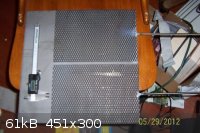
[Edited on 29-5-2012 by hyfalcon]
|
|
|
Swede
Hazard to Others
  
Posts: 491
Registered: 4-9-2008
Member Is Offline
Mood: No Mood
|
|
 You have a power supply capable of pushing juice through those? Wow! What
kind of current densities are you looking at? You have a power supply capable of pushing juice through those? Wow! What
kind of current densities are you looking at?
Remember, the rate at which oxidation takes place is dependent upon current and pH, not necessarily electrode area. 50 amps through a 4" X 6" anode
makes the same chlorate as through a 12" x 12" anode.
Anyway, I am intrigued by the scale you are going for. I personally like to sandwich electrodes, normally two cathodes surrounding a single anode.
1/4" thick Ti is huge overkill for thickness... the cathode is protected and does not erode. You could get away with 0.06" Ti with ease. But the
1/4" stuff would work fine.
If you use ONE cathode with two anodes, it'll work, but your effective anode surface area will not be as good as it could be. I'm guessing the
current flow from the far side of the anode isn't much compared to that portion facing the cathode. With your massive anodes, I'd take one of them,
cut the ti sheet into two pieces, and sandwich the anode with them.
Another option I've often wanted to try is have a Ti cell welded up, and use the entire cell as a cathode. But that's some big $$ for the Ti.
I'd love to hear more about your apparently enormous setup! 
|
|
|
hyfalcon
International Hazard
    
Posts: 1003
Registered: 29-3-2012
Member Is Offline
Mood: No Mood
|
|
My power supply is a dual output 200A constant current or switch to constant voltage, whatever floats your boat. I haven't quit settled on a reaction
chamber yet, but I'm leaning towards a 6.5 gal plastic bucket with a screw top o-ring sealed lid. Cutting this .25" plate down to size is the next
hurdle to surmount. That's a 13.75" square plate by the way. I got it off ebay for 25.00 plus about 18.00 shipping. They have more if you want to
do a massive titanium welding project
These things would make one hell of a Captain America style shield except for it being square instead of round. Might make a good insert for a kevlar
laced fiberglass buildup on top of it....
I picked the power supply up off ebay. No one seems to know what brand it is or much about where it was manufactured. If anyone recognizes something
in these pics, let me know. This is all the description I got for it:
Mode 1&R 0-50V Dynamic Load: DC 120/1KHz Current Range: 10A, 50A, 100A, 200A This item does not have a Manufacturer, Model or Serial no.
Once I get the lab set up, I hope to run the chlorate production on one side and the perchlorate production on the other side. I think I'm going to
have to look for a larger reaction chamber or set up multiple chambers like you had going.
@ Swede, I been meaning to ask you, on your KClO3 rig you had going with the carbon electrodes, What did you use for the actual mechanical connection
to the carbon electrode? I've been scratching my head on that one.
[Edited on 30-5-2012 by hyfalcon]
[Edited on 30-5-2012 by hyfalcon]
[Edited on 31-5-2012 by hyfalcon]
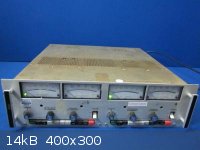 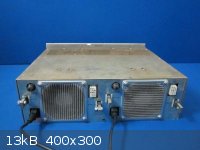 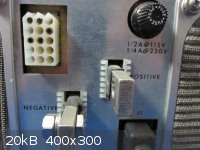
[Edited on 31-5-2012 by hyfalcon]
[Edited on 31-5-2012 by hyfalcon]
|
|
|
dann2
International Hazard
    
Posts: 1523
Registered: 31-1-2007
Member Is Offline
Mood: No Mood
|
|
If you take off the cover you might see some manufacturer name or model number?
|
|
|
hyfalcon
International Hazard
    
Posts: 1003
Registered: 29-3-2012
Member Is Offline
Mood: No Mood
|
|
Took the top off and there is no identifiable marking of any sort. The hunt continues.
|
|
|
Swede
Hazard to Others
  
Posts: 491
Registered: 4-9-2008
Member Is Offline
Mood: No Mood
|
|
It looks like a dual supply. Is there a wattage placard? That'd speak volumes about what sort of energy the unit can deliver to a cell. Dumb
question, what is the input voltage? Usually something of that capacity will do 240V one or three phase. If you can do 0 to 10V and 0 to 100A then
you're golden.
I personally never have used carbon or graphite anodes, so you may have me confused. I know dann2 has used them extensively.
One thing to keep in mind with that monster is the relatively poor conductivity of titanium. Without an adequate shank cross section, you're going to
get some serious heat output. I've seen probably 250 degrees C at 70 amps on a titanium shank that measured 1mm x 25mm. This of course can melt
plastics with ease.
I use #4 Cu welding cable and crimp-on connectors like this:

Another way to do it is to use an aluminum block that clamps onto a rectangular strap section. In this one, I bolted a big surplus heat sink onto the
Al block. The Cu cable connector goes right onto the stainless steel stud (via nuts) embedded in the block. This setup works well because it is
adaptable to any number of Ti strap dimensions, and no hole needs to be drilled in the Ti.

Added: Have you considered lead or tin filled tubular shanks? These are superior for a number of reasons. They can be mounted via an appropriate
PVDF (kynar) compression fitting drilled through for the outer diameter of the tube, and the big one is that the filler metal, Pb or Sn, carries the
current rather than the titanium.
To make one, you heat a Ti tube to dull red, and pinch one end into a flat. This can take 3 or 4 steps as the Ti work hardens, and if you rush it,
it'll crack on the edges. But once the end is flattened, you fill the tube with molen metal, then drill and tap the end for a stud. Onto this goes a
standard Cu crimp connector, like so:


[Edited on 14-6-2012 by Swede]
|
|
|
hyfalcon
International Hazard
    
Posts: 1003
Registered: 29-3-2012
Member Is Offline
Mood: No Mood
|
|
It's a dual output, 200 amp 50v max power supply.
Here's some anode porn for you!
I just picked this up off ebay. Blasted thing is 20in. long
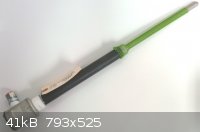
Now I really do have to find that stainless steel 55gal drum or maybe this will work?
| Code: | http://www.ebay.com/itm/Stainless-Steel-Drum-Barrels-/300606246444?pt=LH_DefaultDomain_0&hash=item45fd874e2c#shId |
[Edited on 15-6-2012 by hyfalcon]
|
|
|
dann2
International Hazard
    
Posts: 1523
Registered: 31-1-2007
Member Is Offline
Mood: No Mood
|
|
What is the Anode made from and what is is meant to be used for?
|
|
|
hyfalcon
International Hazard
    
Posts: 1003
Registered: 29-3-2012
Member Is Offline
Mood: No Mood
|
|
It's a clad platinum tip about 9in long used for corrosion abatement. Total length is 22in.
|
|
|
gregkdc1
Harmless

Posts: 5
Registered: 22-10-2011
Member Is Offline
Mood: No Mood
|
|
Here is a thought for an anode that I don't think anybody has tried at least from what I have read. Usually there is a good reason for why something
like this wont work so if you are inclined to tell me why it won’t work please be gentle. Anyways I read a patent that was talking about using
manganese dioxide that has a little silicon dioxide added to the oxide layer to reinforce it. I was really excited about trying this until I realized
how hard it could be to get the silicon precursor chemicals. I also read how lead itself will make perchlorate from the lead dioxide that is formed
on its surface all be it extremely poorly because the oxide flakes off. Then it hit me has anybody tried alloying metals of say manganese with a
little titanium or tin/lead/silicon to make an anode? The idea is that you make a solid metal anode that forms the conductive oxide coat when placed
in a perchlorate cell, but you change the chemistry so the oxide coat adheres well to the anode and is stable? One obvious benefit would be if the
layer flake off or got damaged it could heal itself.
|
|
|
Swede
Hazard to Others
  
Posts: 491
Registered: 4-9-2008
Member Is Offline
Mood: No Mood
|
|
^^ The problem with your scenario if I read it correctly is that any sort of "self-healing/plating anode" isn't going to adhere, it'll simply form
dust or solubles that don't stick well. And besides, the chemistry of chlorate/perchlorate electrolysis is entirely different from that of a plating
tank.
I have not experimented with Mn/oxides in any form with this process. I am unsure whether it will work. Anyone know?
|
|
|
| Pages:
1
..
41
42
43
44
45
..
48 |